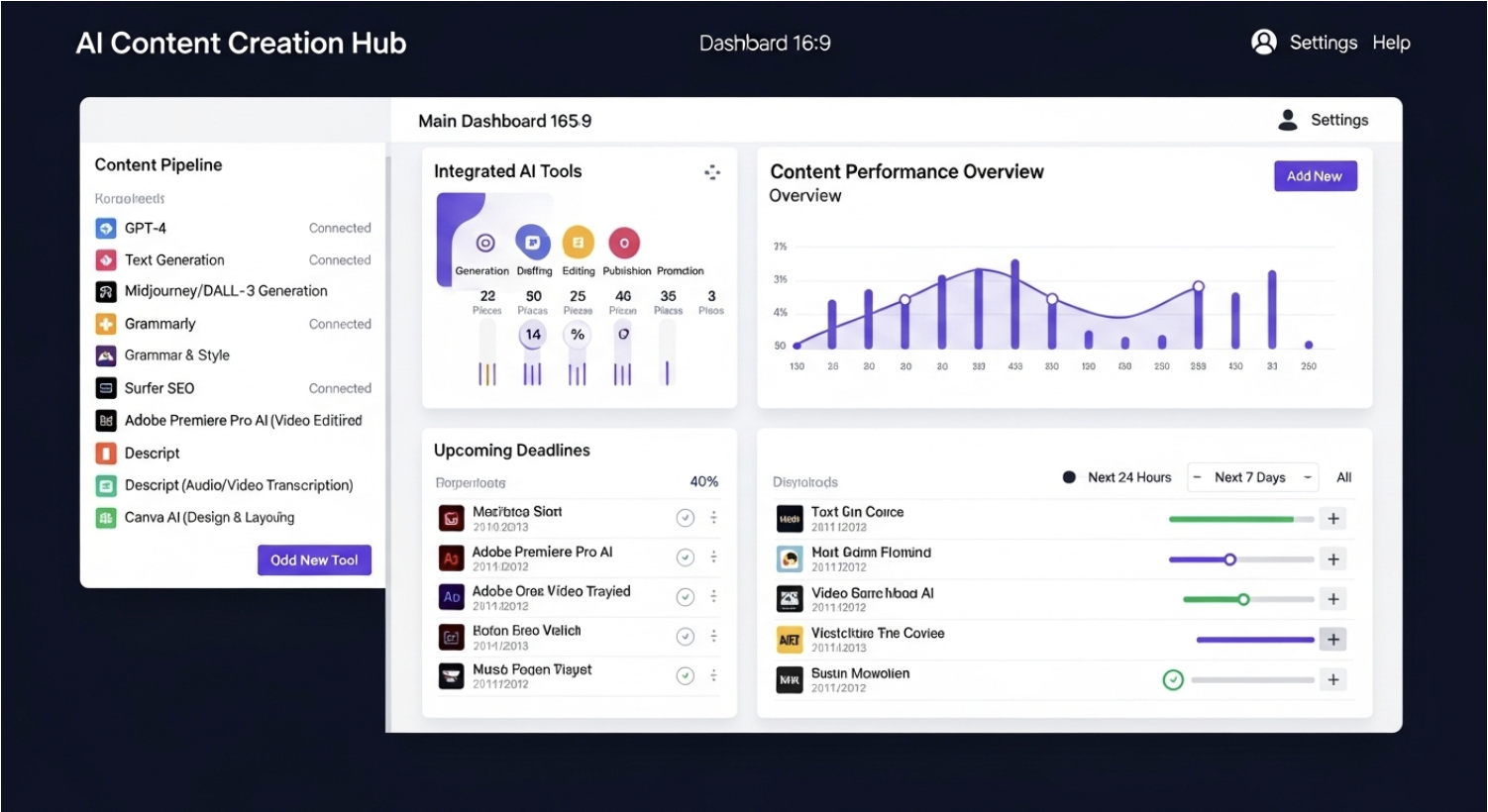AI blog writing is transforming how businesses create content. This guide covers everything from understanding AI’s role in content creation to implementing advanced strategies. You’ll learn how AI enhances efficiency, scales production, and optimizes for SEO, while empowering human writers. We discuss choosing the right tools, crafting effective prompts, and ensuring content quality through human-AI collaboration. The post also features a case study, a practical toolkit, and addresses common FAQs, emphasizing that AI is a powerful co-pilot, not a replacement for human creativity. Embrace AI to streamline your content workflow and achieve remarkable results.
Table of Contents
- Introduction: The Dawn of AI in Content Creation
- What is AI Blog Writing?
- The Benefits of Integrating AI into Your Blog Workflow
- Getting Started with AI Blog Writing: Tools and Techniques
- Best Practices for Human-AI Collaboration
- Advanced Strategies for AI-Powered Content
- Case Study: Boosting Blog Traffic with AI
- Practical Toolkit & Checklist for AI Blog Writers
- Key Facts About AI Blog Writing
- The Future of AI in Content Creation
- Frequently Asked Questions (FAQ)
- Conclusion: Embracing the AI-Powered Content Revolution
Introduction: The Dawn of AI in Content Creation
In today’s fast-paced digital world, content is king. Businesses and individuals constantly need fresh, engaging, and high-quality content to capture audience attention and drive growth. However, producing a steady stream of blog posts can be time-consuming and resource-intensive. This is where AI blog writing steps in, offering a revolutionary solution.
Artificial Intelligence (AI) has rapidly evolved, moving beyond simple automation to sophisticated text generation. Indeed, AI tools are now capable of understanding context, generating coherent narratives, and even mimicking various writing styles. As a result, many content creators are exploring how to leverage these powerful technologies. This comprehensive guide will explore every facet of AI blog writing, helping you understand its potential and integrate it effectively into your content strategy.
What is AI Blog Writing?
Simply put, AI blog writing involves using Artificial Intelligence software to assist in the creation of blog content. These tools are powered by advanced algorithms, primarily Natural Language Processing (NLP) and Machine Learning (ML). They analyze vast amounts of text data to learn patterns, grammar, style, and factual information. Then, they use this knowledge to generate new text based on user prompts.
At its core, AI blog writing aims to streamline the content creation process. For example, AI can help with brainstorming ideas, outlining articles, drafting full sections, or even optimizing content for search engines. It acts as a powerful assistant, allowing human writers to focus on higher-level tasks like strategic planning and quality control. Therefore, understanding its capabilities is crucial for modern content teams.
How AI Blog Writing Tools Work
Most AI writing tools operate on a few key principles. First, they take an input, typically a text prompt provided by the user. This prompt can be a simple topic, a few keywords, or a detailed outline. Second, the AI model processes this input, drawing upon its extensive training data. It identifies relevant information and structures it into a coherent response.
Furthermore, these tools use predictive text generation. They anticipate the most likely next word or phrase, constructing sentences and paragraphs sequentially. The output is then presented to the user, who can refine, edit, or prompt for further generation. This iterative process allows for significant flexibility and customization. Consequently, the quality of the output heavily depends on the clarity and specificity of the initial prompt.

The Benefits of Integrating AI into Your Blog Workflow
Incorporating AI blog writing into your content strategy offers a multitude of advantages. These benefits can significantly impact your team’s productivity, your content’s reach, and ultimately, your business’s bottom line. Let’s explore some of the most compelling reasons to embrace AI.
Enhanced Efficiency and Speed
One of the most immediate benefits of AI in content creation is the drastic improvement in efficiency. AI tools can generate initial drafts, outlines, or ideas in a fraction of the time it would take a human writer. For example, brainstorming sessions that once took hours can now be condensed into minutes with AI assistance. This frees up human writers to focus on more complex tasks, such as in-depth research, strategic planning, and adding unique insights. Consequently, you can publish content much faster.
Scaling Content Production
Many businesses struggle to produce enough content to meet their marketing goals. AI blog writing provides a powerful solution for scaling content production without proportionally increasing staffing costs. With AI, you can generate more blog posts, articles, and marketing copy than ever before. This expanded output helps maintain a consistent online presence, reaching wider audiences and improving SEO. Moreover, it allows businesses to experiment with different content formats and topics more easily.
Overcoming Writer’s Block
Writer’s block is a common nemesis for content creators. Staring at a blank page can be frustrating and unproductive. Fortunately, AI tools serve as an excellent antidote. They can quickly provide initial ideas, draft starter paragraphs, or suggest different angles for a topic. This immediate kickstart helps break through creative barriers, ensuring a smoother and more consistent writing process. Therefore, AI acts as a valuable creative partner, offering fresh perspectives when inspiration wanes.
SEO Optimization Capabilities
Many AI writing platforms are integrated with SEO features. They can analyze keywords, suggest optimal content structures, and even help craft meta descriptions and titles. This integration ensures that your blog posts are not only well-written but also discoverable by search engines. As a result, your content has a better chance of ranking higher, driving more organic traffic to your site. This is a significant advantage for any online business.
For businesses looking to fully leverage AI for their content strategy, it’s vital to have a clear roadmap. Understanding how to build an AI content strategy can ensure that AI tools are used effectively, aligning with overall business goals and maximizing SEO benefits.
Cost-Effectiveness
While AI tools do come with a subscription cost, they often prove to be more cost-effective in the long run compared to hiring additional human writers or outsourcing extensively. They reduce the time spent on repetitive tasks, allowing your existing team to produce more. Furthermore, the ability to generate a high volume of content quickly can lead to a faster return on investment through increased traffic and conversions. Thus, AI offers a compelling economic argument for content creation.
Getting Started with AI Blog Writing: Tools and Techniques
Embarking on your journey with AI blog writing requires understanding the available tools and mastering effective techniques. It’s not just about pushing a button; it involves skillful prompting and thoughtful refinement.
Choosing the Right AI Writing Tool
The market is flooded with AI writing tools, each with its unique strengths. Some are general-purpose, excellent for various content types, while others specialize in specific tasks like copywriting or long-form articles. Consider your primary needs: Do you need help with brainstorming, drafting, or optimization? Look for features such as ease of use, integration capabilities, and cost. Reading reviews and trying free trials can help you find the best fit for your workflow. Popular tools often offer different pricing tiers to match various usage levels.
Crafting Effective Prompts
The quality of AI-generated content heavily relies on the quality of your prompts. Think of a prompt as clear instructions to a human assistant. Be specific, provide context, and define the desired output.
- Define the Goal: What do you want the AI to achieve? (e.g., “write a blog post introduction,” “generate five blog post ideas”).
- Provide Context: Include background information, target audience, and desired tone (e.g., “for small business owners, informative and encouraging tone”).
- Specify Keywords: Integrate primary and secondary keywords for SEO.
- Set Constraints: Specify length, format (e.g., “3 paragraphs,” “bullet points”), or style.
For instance, instead of “Write about AI,” try: “Write an engaging blog post introduction about the benefits of AI in small business marketing, targeting novice entrepreneurs, using a helpful and optimistic tone. Include keywords like ‘AI marketing tools’ and ‘business growth’.”
The Iterative Process: AI Draft to Human Polish
AI blog writing is rarely a one-shot process. It’s an iterative dance between AI generation and human refinement. Start with a broad prompt, then refine the output with subsequent prompts. For instance, ask the AI to expand on a specific point, rephrase a sentence, or summarize a section. After the AI provides a satisfactory draft, a human writer must step in. This final polish ensures factual accuracy, maintains brand voice, and adds the nuanced human touch that resonates with readers. Remember, AI drafts are excellent starting points, not final products.
Integrating AI for Specific Tasks
AI can assist at various stages of the blog writing process:
- Ideation: Generate endless topic ideas based on keywords or niche.
- Outlines: Create structured outlines with H2/H3 headings for any topic.
- Full Drafts: Produce initial full-length drafts, which human editors can then refine.
- Summaries & Introductions: Quickly craft compelling intros or concise summaries.
- Rewriting & Paraphrasing: Improve clarity, tone, or avoid plagiarism.
- SEO Optimization: Suggest keywords, optimize meta descriptions, and check readability.
By breaking down the writing process, you can leverage AI where it’s most effective, saving significant time and effort. This modular approach to content creation boosts overall productivity.

Best Practices for Human-AI Collaboration
To truly excel in AI blog writing, a harmonious collaboration between human creativity and AI efficiency is essential. It’s about maximizing the strengths of both.
AI as a Co-Pilot, Not a Replacement
It’s crucial to view AI as a powerful co-pilot, a tool that augments human capabilities, rather than a full replacement. Human writers bring unique perspectives, critical thinking, emotional intelligence, and creativity that AI cannot replicate. Use AI for mundane, repetitive tasks or to overcome initial hurdles. Then, infuse the content with your unique voice, insights, and storytelling. This partnership ensures that your content remains authentic and engaging.
Fact-Checking and Accuracy
AI models, while sophisticated, are prone to “hallucinations”—generating factually incorrect or nonsensical information. Always, without exception, fact-check every piece of information generated by AI. Cross-reference data with reliable sources, verify statistics, and ensure names, dates, and figures are accurate. Relying solely on AI for facts can lead to embarrassing errors and damage your credibility. For instance, major news outlets often employ rigorous fact-checking protocols, as highlighted by organizations like Poynter Institute.
Injecting Brand Voice and Personality
AI can mimic various tones, but it often struggles to capture the nuanced and authentic voice of a specific brand. After AI generates a draft, dedicate time to infuse your brand’s unique personality. Adjust word choices, sentence structures, and rhetorical devices to match your established style guide. This human touch ensures consistency across all your content and strengthens brand identity. Your audience connects with authentic voices, therefore this step is paramount.
Ethical Considerations and Transparency
As AI becomes more prevalent, ethical considerations grow. Be transparent with your audience about your use of AI, if appropriate. Avoid claiming AI-generated content as purely human-created, especially in sensitive areas. Furthermore, be mindful of potential biases embedded in AI models, which can inadvertently lead to discriminatory or inaccurate content. Regularly review your AI outputs for fairness and inclusivity. The responsible use of AI builds trust and maintains integrity. The principles developed by leading AI companies offer valuable guidance in this area.
Advanced Strategies for AI-Powered Content
Once you’re comfortable with the basics, you can explore more sophisticated ways to leverage AI blog writing. These advanced strategies can significantly enhance your content’s impact and reach.
Personalization and Audience Targeting
AI can help tailor content to specific audience segments. By analyzing user data and preferences, AI tools can suggest content topics or even variations of existing content that resonate more deeply with particular groups. For instance, an e-commerce blog could use AI to generate different versions of a product description, each aimed at a distinct demographic. This personalization leads to higher engagement rates and improved conversion. As a result, your content feels more relevant to each reader.
Multilingual Content Generation
Global reach is easier than ever with AI. Many AI writing tools offer robust translation and multilingual content generation capabilities. You can create a blog post in English and then use AI to translate and adapt it for audiences speaking Spanish, German, or Japanese. This significantly reduces the cost and complexity of entering new markets. Moreover, AI can often understand cultural nuances better than traditional machine translation, resulting in more natural-sounding content. This capability is especially beneficial for international businesses.
Content Repurposing with AI
Repurposing content is a smart way to maximize its value. AI can quickly transform long-form blog posts into various formats:
- Social Media Posts: Extract key takeaways and craft engaging captions.
- Email Newsletters: Summarize the main points for a concise update.
- Video Scripts: Convert blog sections into dialogue for video content.
- Infographics: Pull out statistics and facts for visual representation.
This efficiency ensures your message reaches different audiences across multiple platforms, strengthening your overall content ecosystem. A well-defined content strategy, enhanced by AI, can effectively manage this content flow. Learning how to build an AI content strategy can therefore guide your efforts in repurposing.
Case Study: Boosting Blog Traffic with AI
Let’s look at a practical example of how AI can transform a company’s content efforts.
Scenario: TechFlow Solutions
TechFlow Solutions, a rapidly growing SaaS company offering project management software, faced a common challenge. Their blog, critical for lead generation and brand authority, struggled with inconsistent output. Their small marketing team could only manage 4-6 high-quality posts per month. This limited their SEO reach and made it difficult to compete with larger players in their niche. Writer’s block was frequent, and the demand for fresh content outstripped their capacity.
Problem: Low Output and Inconsistent Quality
The core issues were clear: a low volume of new articles, slow production cycles, and a struggle to consistently cover a wide array of relevant topics. The team spent too much time on initial drafting and research, leaving less time for strategic planning and promotion. As a result, their organic traffic growth stagnated, and their SEO competitive edge began to dull.
Solution: Implementing AI Blog Writing Tools
TechFlow Solutions decided to integrate AI blog writing tools into their workflow. They chose an AI content suite that offered features for keyword research, outline generation, long-form drafting, and content optimization.
- Ideation: The AI tool quickly generated hundreds of blog post ideas based on their target keywords and competitor analysis.
- Outline Generation: For selected topics, AI crafted detailed outlines with relevant headings and subheadings, saving hours of structuring.
- First Drafts: The marketing team used AI to create initial drafts for specific sections or even entire articles. This provided a strong foundation.
- SEO Enhancement: The AI suggested keyword insertions, readability improvements, and optimized meta descriptions.
- Human Polish: Human writers then reviewed, fact-checked, added unique insights, brand voice, and refined the AI-generated content.
This process transformed their content pipeline, allowing them to scale efficiently.
Results: Remarkable Growth
Within six months of implementing AI, TechFlow Solutions saw significant improvements:
- Increased Content Volume: They boosted their blog output from 4-6 posts per month to 15-20 posts. This consistent stream helped them cover more topics relevant to their audience.
- Traffic Growth: Organic blog traffic increased by 120% due to the higher volume of keyword-optimized content.
- Improved Engagement: While AI provided the foundation, the human polish ensured the content was still engaging and resonated with their audience, leading to a 30% increase in average time on page.
- Cost Savings: They avoided hiring two additional full-time writers, saving significant budget.
- Enhanced Writer Morale: Writers were less prone to burnout and could focus on creative aspects rather than repetitive drafting.
This case study demonstrates the immense potential of AI blog writing when used strategically and collaboratively with human talent. It truly unlocked their content potential.
Practical Toolkit & Checklist for AI Blog Writers
Equipping yourself with the right tools and a systematic approach is key to successful AI blog writing.
Essential AI Tools
- AI Writing Assistant: Platforms like Jasper, Copy.ai, or Frase.io for generating content, outlines, and ideas.
- SEO Tool: Ahrefs, SEMrush, or Surfer SEO for keyword research, competitor analysis, and content optimization.
- Grammar & Plagiarism Checker: Grammarly, ProWritingAid, or Turnitin to ensure quality and originality.
- Content Planner/Calendar: Trello, Asana, or a custom spreadsheet to organize your content pipeline.
Prompt Engineering Best Practices Checklist
- Be Clear and Concise: Avoid ambiguity in your requests.
- Provide Context: Explain the purpose, audience, and background.
- Specify Tone & Style: Informative, casual, professional, witty, etc.
- Include Keywords: List primary and secondary keywords for SEO.
- Define Format & Length: Specify headings, paragraphs, bullet points, word count.
- Use Examples (if possible): Show the AI what kind of output you expect.
- Iterate and Refine: Start broad, then narrow down with follow-up prompts.
Content Quality Assurance Checklist
- Fact-Check All Information: Verify data, statistics, and claims from reliable sources.
- Edit for Coherence and Flow: Ensure smooth transitions between paragraphs and ideas.
- Inject Brand Voice & Personality: Make sure the content sounds like your brand.
- Check for Plagiarism: Use a tool to confirm originality.
- Optimize for Readability: Short sentences, simple language, active voice.
- Review SEO Elements: Keywords, meta descriptions, titles, image alt text.
- Proofread for Grammar & Spelling: Catch any lingering errors.

Automating Your Content Workflow
For businesses serious about scaling content, an AI-powered content suite is invaluable. Platforms like BlogZenn.com offer an integrated solution to automate various stages of content production. Imagine a single tool that can handle:
- Automated Research: Quickly gather data and insights on any topic.
- Efficient Drafting: Generate full articles, introductions, or specific sections based on your inputs.
- Visual Creation: Suggest or even generate relevant images and graphics to accompany your text.
This comprehensive approach significantly reduces manual effort and time investment. By centralizing these functions, an AI content suite empowers your team to produce high-quality, SEO-optimized content at an unprecedented pace. This directly translates to saving time and drastically helps to scale content production for businesses of all sizes, ensuring you stay ahead in the competitive digital landscape. Integrating such tools is a critical step in developing a robust AI content strategy.
Key Facts About AI Blog Writing
| Aspect | Key Insight |
|---|---|
| Role of AI | AI serves as a co-pilot, not a replacement for human writers. It automates repetitive tasks. |
| Efficiency Boost | Can reduce content creation time by up to 80% for initial drafts. |
| Content Scaling | Enables businesses to produce a significantly higher volume of content consistently. |
| SEO Impact | AI tools assist in keyword optimization, outline generation, and readability scores. |
| Accuracy | AI-generated content requires rigorous human fact-checking to ensure accuracy. |
| Human Touch | Essential for injecting brand voice, personality, and unique insights. |
| Prompt Engineering | The quality of AI output is directly proportional to the clarity and detail of the input prompt. |
| Market Adoption | A growing number of content creators and marketers are integrating AI into their workflows. A report by Statista projects significant growth in the AI content generation market. |
The Future of AI in Content Creation
The landscape of content creation is continuously evolving, with AI at its forefront. The future of AI blog writing promises even more sophisticated capabilities and deeper integration into creative workflows.
Evolving Capabilities
Future AI models will likely offer even greater nuance in language generation, improved understanding of complex prompts, and enhanced abilities to maintain consistent brand voices across vast amounts of content. We can expect AI to become better at generating highly personalized content, adapting to real-time audience feedback, and even proactively suggesting content ideas based on market trends. This ongoing development will make AI an even more indispensable tool for marketers and writers. The rapid advancements in large language models (LLMs) like GPT-4, as detailed by OpenAI, suggest a continuous upward trajectory.
The Role of Human Creativity
Despite AI’s growing sophistication, human creativity will remain paramount. AI will handle the heavy lifting of drafting and optimization, allowing humans to focus on strategic thinking, innovative storytelling, and injecting unique perspectives that resonate emotionally. The human element will be the differentiator, adding the empathy, cultural understanding, and critical judgment that AI currently lacks. Thus, the future is not about AI replacing humans, but rather AI empowering them to achieve more.
Addressing Challenges and Limitations
As AI advances, so will the need to address its limitations and challenges. Issues like factual accuracy, bias mitigation, and the potential for content commoditization will require ongoing attention. Developers and users must work together to establish best practices and ethical guidelines for AI content creation. Furthermore, a forward-thinking approach to building an AI content strategy will be essential to navigate these evolving challenges and opportunities effectively.
Frequently Asked Questions (FAQ)
Q1: Can AI truly replace human writers?
No, AI cannot fully replace human writers. While AI excels at generating text, structuring content, and optimizing for SEO, it lacks genuine creativity, emotional intelligence, critical thinking, and the ability to inject unique human experiences. AI serves as a powerful assistant or co-pilot, significantly enhancing human productivity rather than replacing it.
Q2: How accurate is AI-generated content?
AI-generated content can be quite accurate, especially when provided with clear, factual prompts. However, AI models are known to “hallucinate” or generate incorrect information. Therefore, it is absolutely critical for human writers to fact-check, verify, and edit all AI-generated content before publication.
Q3: Is AI blog writing expensive?
The cost of AI blog writing tools varies widely, from free basic versions to premium subscriptions for advanced features. While there’s an investment, AI can be highly cost-effective in the long run. It reduces the need for additional human resources and significantly speeds up content production, leading to a higher ROI for many businesses.
Q4: How do I ensure originality with AI content?
AI tools generate new text based on their training data, but sometimes outputs can unintentionally resemble existing content. To ensure originality, always use a plagiarism checker on AI-generated drafts. More importantly, human writers should add their unique insights, analysis, and brand voice to differentiate the content.
Q5: Will AI content be penalized by search engines like Google?
Google has stated that it prioritizes helpful, high-quality, and original content, regardless of how it’s produced. Content written solely by AI without human oversight or valuable insights may struggle to rank. However, if AI is used to assist in creating valuable, factually accurate, and well-optimized content that genuinely serves the user, it will not be penalized. The focus remains on content quality and user experience, as Google’s guidance on AI content confirms.
Conclusion: Embracing the AI-Powered Content Revolution
The advent of AI blog writing marks a significant turning point in content creation. It’s no longer a futuristic concept but a powerful reality transforming how businesses and individuals approach their content strategies. From boosting efficiency and scaling production to overcoming creative blocks and enhancing SEO, AI offers unparalleled advantages.
However, the true power of AI lies in its synergistic partnership with human intelligence. When used as a co-pilot, with careful oversight, fact-checking, and the infusion of unique brand voice, AI becomes an incredible enabler. It frees up human creativity to focus on what truly matters: delivering exceptional value, building connections, and crafting compelling narratives.
Embrace this AI-powered content revolution. Learn the tools, master the techniques, and integrate best practices. By doing so, you can streamline your workflow, produce more impactful content, and ultimately achieve remarkable success in the ever-competitive digital landscape. The future of content is here, and it’s a collaborative masterpiece between human ingenuity and artificial intelligence.

